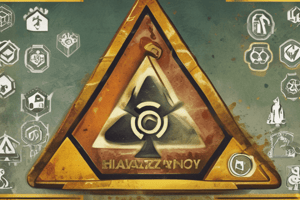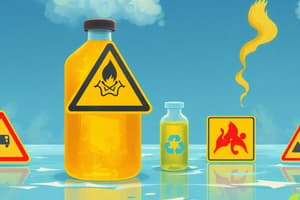Podcast
Questions and Answers
What is the primary purpose of hazard symbols?
What is the primary purpose of hazard symbols?
- To confuse users of chemicals
- To ensure higher sales of chemicals
- To decorate laboratory equipment
- To standardize communication about chemical hazards (correct)
All hazardous substances are safe to handle as long as proper precautions are taken.
All hazardous substances are safe to handle as long as proper precautions are taken.
False (B)
What should be done with gas under pressure to ensure safety?
What should be done with gas under pressure to ensure safety?
Cylinders should be stored in cool areas and kept upright.
A substance that is __________ can explode due to fire, heat, shock, and friction.
A substance that is __________ can explode due to fire, heat, shock, and friction.
Which of the following is a correct handling procedure for corrosive substances?
Which of the following is a correct handling procedure for corrosive substances?
Match the hazard type with its description:
Match the hazard type with its description:
What is an appropriate way to dispose of hazardous substances?
What is an appropriate way to dispose of hazardous substances?
Knowledge of hazardous symbols is only necessary for those working directly with chemicals.
Knowledge of hazardous symbols is only necessary for those working directly with chemicals.
What is the primary risk associated with flammable liquids?
What is the primary risk associated with flammable liquids?
Oxidizing substances can burn in the absence of air.
Oxidizing substances can burn in the absence of air.
What should be avoided when handling irritant substances?
What should be avoided when handling irritant substances?
Carcinogenic substances can cause __________ health damage.
Carcinogenic substances can cause __________ health damage.
Match the hazardous symbols with their corresponding descriptions:
Match the hazardous symbols with their corresponding descriptions:
Which of the following is a proper handling method for oxidizing substances?
Which of the following is a proper handling method for oxidizing substances?
Only explosive substances are a concern when it comes to shock and friction.
Only explosive substances are a concern when it comes to shock and friction.
Harmful substances should be kept away from __________ to prevent skin irritation.
Harmful substances should be kept away from __________ to prevent skin irritation.
Flashcards
Flammable Liquid
Flammable Liquid
A substance that catches fire easily when exposed to sparks or fire.
Handling Flammable Liquids
Handling Flammable Liquids
Keep them away from ignition sources and heat.
Irritant
Irritant
Substances that can cause irritation to skin and eyes.
Handling Irritants
Handling Irritants
Signup and view all the flashcards
Oxidizing Agents
Oxidizing Agents
Signup and view all the flashcards
Handling Oxidizing Agents
Handling Oxidizing Agents
Signup and view all the flashcards
Carcinogenicity
Carcinogenicity
Signup and view all the flashcards
Handling Carcinogens
Handling Carcinogens
Signup and view all the flashcards
Hazard Symbols
Hazard Symbols
Signup and view all the flashcards
Environmental Toxicity
Environmental Toxicity
Signup and view all the flashcards
Acutely Toxic
Acutely Toxic
Signup and view all the flashcards
Gas Under Pressure
Gas Under Pressure
Signup and view all the flashcards
Corrosive
Corrosive
Signup and view all the flashcards
Explosive
Explosive
Signup and view all the flashcards
Flammable
Flammable
Signup and view all the flashcards
Safe Handling Practices
Safe Handling Practices
Signup and view all the flashcards
Study Notes
Hazardous Symbols
- Hazard symbols are created by the UN for standardized communication about chemical hazards.
- Knowing these symbols helps protect people and the environment from hazardous chemicals.
- They also help with international trading of chemicals.
- Most lab equipment and chemicals are marked with these symbols.
- These symbols should be considered during investigations.
- They highlight potential health & safety hazards of chemicals and equipment.
Environmental Toxicity
- Symbol: Image of a tree with a slash through it.
- Description: Toxic to the environment, specifically organisms.
- Handling: Dispose of responsibly.
Acutely Toxic
- Symbol: Image of a skull and crossbones.
- Description: Life-threatening with limited exposure.
- Handling: Avoid skin contact.
Gas Under Pressure
- Symbol: Image of a cylinder.
- Description: Pressurized gas; may be cold or explosive when heated.
- Handling: Store cylinders upright in cool areas.
Corrosive
- Symbol: Image of a beaker with acid in it.
- Description: Burns skin, damages eyes, and corrodes metal.
- Handling: Avoid skin contact and pour acid into water, not vice-versa. Wash off with water.
Explosive
- Symbol: Image of an explosion.
- Description: Explodes due to fire, heat, shock, and friction (lots of chemical energy).
- Handling: Keep away from ignition sources.
Flammable
- Symbol: Image of a burning flame.
- Description: Catches fire easily when exposed to sparks or fire, flammable liquid examples include petrol and kerosene.
- Handling: Keep away from ignition sources.
Harmful/Irritant
- Symbol: Image of an exclamation point.
- Description: Irritates skin.
- Handling: Keep away from skin and eyes.
Oxidising
- Symbol: Image of a burning flame with an open top.
- Description: Burns in the absence of air.
- Handling: Keep away from ignition sources.
Carcinogenicity/Aspiration Hazard
- Symbol: Image of a person with a cough.
- Description: Long-term health damage such as cancer, breathing difficulties.
- Handling: Avoid contact with skin and ingestion.
Studying That Suits You
Use AI to generate personalized quizzes and flashcards to suit your learning preferences.




